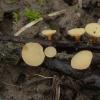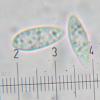
04-01-2026 17:45
 Stephen Martin Mifsud
Stephen Martin Mifsud
I was happy to find these orange asmocyetes which

03-01-2026 13:08
Niek SchrierHi all,We found groups of perithecia on a Lecanora

29-12-2025 17:44
Isabelle CharissouBonjour,J'aimerais savoir si d'autres personnes au

02-01-2026 17:43
MARICEL PATINOHi there, although I couldn't see the fruitbody, I

01-01-2026 18:35
Original loamy soil aside a artificial lake.The co

31-12-2025 19:27
Collected from loamy soil, at waterside (completel
Hymenoscyphus latisporus
Yannick Mourgues,
19-11-2008 15:02
 Bonjour à tous.
Bonjour à tous.Je m'interroge sur cette espèce et aimerai votre avis. Mes clés m'amènent vers H. latisporus mais sans grande conviction.
Ecologie :
Sur brindilles de Corylus tombées au sol.
Macro :
Cf. photo. Stipe court de 1 à 4 mm, de couleur jaune à brun. Hymenium jaune pâle de diamètre jusqu'à 5 mm.
Micro :
Spores cylindriques , lisses, hyalines, avec de nombreuses guttules allant jusqu'à 1 um de diamètre, 15-18x5,1-5,8 um, Q=2,6-3,4. Avec parfois 1 cloison
Asques 110-130x8-10 um, boucles +, IKI- (!!!! Mon Lugol est neuf!)
Paraphyses cylindriques, parfois un peu irrégulières ("cabossées"), septées (au moins deux cloisons), larges de 3-4 um, dernier article rempli de guttules.
Questions :
H. latisporus est-il toujours une espèce valide ? Est-ce que mon espèce peut correspondre ? Quelle est la différence exacte entre le genre Hymenoscyphus et Phaeohelotium, car au départ j'étais parti sur ce dernier genre ?
Merci par avance.
Yannick Mourgues
Hi.
I've found a specie that could be Hymenoscyphus latisporus. But I'm not sure.
I've found them on Corylus twigs, on the ground. Many Fagus all around.
Cf. picture. Apothecia scutellate, up to 5 mm diameter, pale yellow, reddening, stalked up to 4 mm. Asci 110-130x8-10 um, arising from croziers, IKI- (My Lugol is new!!!). Spores 0(1)-septate, 15-18x5,1-5,8 um, Q=2,6-3,4 , with many guttules up to 1µm diameter. Paraphyses filled with strongly refractive guttules. Paraphyses up to 3-4 um wide.
Question :
Is H. latisporus a good specie ? Is my specie H. latisporus ? What is the difference between Hymenoscyphus genus and Phaeohelotium genus ?
Many thanks.
Yannick Mourgues
Hans-Otto Baral,
19-11-2008 16:39

Re:Hymenoscyphus latisporus
Hi Yannick
I think this is quite typical Hymenoscyphus calyculus. However, I do not remember ever have seen a negative IKI-reaction here. Coudl you make a photo of the ascus apex in IKI, please?
The species is somewhat variable and not always sharply delimited from H. conscriptus. H. calyculus has usually a few larger LBs in the spores among the smaller ones, unlike your spores.
Phaeohelotium, if separable at all from Hymenoscyphus, has never stipes longer than thick, so impossible here. Also the ectal excipulum on the lower flanks is of quite isodiametrical cells while in Hymenoscyphus it is of a t. prismatica with cells distinctly longer than wide and usually oriented at a low angle to the surface.
Zotto.
I think this is quite typical Hymenoscyphus calyculus. However, I do not remember ever have seen a negative IKI-reaction here. Coudl you make a photo of the ascus apex in IKI, please?
The species is somewhat variable and not always sharply delimited from H. conscriptus. H. calyculus has usually a few larger LBs in the spores among the smaller ones, unlike your spores.
Phaeohelotium, if separable at all from Hymenoscyphus, has never stipes longer than thick, so impossible here. Also the ectal excipulum on the lower flanks is of quite isodiametrical cells while in Hymenoscyphus it is of a t. prismatica with cells distinctly longer than wide and usually oriented at a low angle to the surface.
Zotto.
Yannick Mourgues,
19-11-2008 22:33

Re:Hymenoscyphus latisporus
Hi Zotto.
Unfortunately, all my collection is dry now. I forgot them on my desk...
So I have made new pictures of ascus pex in IKI with dried specimen.
I dismissed H. calyculus because in my collection spores are rounded at both ends. They are not scutuloid.
Do you think it's anyway H. calyculus ?
Yannick
Unfortunately, all my collection is dry now. I forgot them on my desk...
So I have made new pictures of ascus pex in IKI with dried specimen.
I dismissed H. calyculus because in my collection spores are rounded at both ends. They are not scutuloid.
Do you think it's anyway H. calyculus ?
Yannick
Hans-Otto Baral,
19-11-2008 22:47

Re:Hymenoscyphus latisporus
Hi Yannick
they are scutuloid enough, it is typical that calyculus has not such heteropolar spores like H. scutula. Anyhow I can recognize the upper end in each of your spores. In species as H. menthae or H. macroguttatus you almost never can say which is the upper end.
But as I said, it would be necessary to see the ascus apex in IKI, no probolem with dried material, simply make it wet again.
Zotto
they are scutuloid enough, it is typical that calyculus has not such heteropolar spores like H. scutula. Anyhow I can recognize the upper end in each of your spores. In species as H. menthae or H. macroguttatus you almost never can say which is the upper end.
But as I said, it would be necessary to see the ascus apex in IKI, no probolem with dried material, simply make it wet again.
Zotto
Hans-Otto Baral,
19-11-2008 23:02

Re:Hymenoscyphus latisporus
Yes, this looks negative. Now tell me, how did you arrive at H. latispora and where is this species described? (I hope not by myself :-)
Zotto
Zotto
Yannick Mourgues,
19-11-2008 23:17

Re:Hymenoscyphus latisporus
I arrived to this specie with this key :
The genus HYMENOSCYPHUS S.F.Gray sensu lato in Belgium.
Key to the species and varieties. by Bernard Declercq (*)
I 've found it on your DVD !
H. latispora is described in the table 3, page 8 :
10 Ascoporus IKI- 11
10' Ascoporus weakly to strongly blued in IKI 12
11 Apothecia turbinate, 1-3(4) mm diameter, yellowish, subsessile to shortly stalked, fleshy. Asci 100-125x11-15 µm, porus IKI-, arising from ???. Spores pale brown and roughened when ripe, 1(3)-septate, 14-16(20)x5,5-7 µm, with several guttules, OCI = .... On wet rotten wood and twigs of ?Quercus. Phen.: VIII. Hymenoscyphus latisporus Declercq sp. nov. ined.
Phaeohelotium?
The genus HYMENOSCYPHUS S.F.Gray sensu lato in Belgium.
Key to the species and varieties. by Bernard Declercq (*)
I 've found it on your DVD !
H. latispora is described in the table 3, page 8 :
10 Ascoporus IKI- 11
10' Ascoporus weakly to strongly blued in IKI 12
11 Apothecia turbinate, 1-3(4) mm diameter, yellowish, subsessile to shortly stalked, fleshy. Asci 100-125x11-15 µm, porus IKI-, arising from ???. Spores pale brown and roughened when ripe, 1(3)-septate, 14-16(20)x5,5-7 µm, with several guttules, OCI = .... On wet rotten wood and twigs of ?Quercus. Phen.: VIII. Hymenoscyphus latisporus Declercq sp. nov. ined.
Phaeohelotium?
Yannick Mourgues,
19-11-2008 23:20

Re:Hymenoscyphus latisporus
It's very strange for me to see a negative reaction in ascus apex. Have you seen it before for H. calyculus ?
Do we know why it's a negative reaction ?
Yannick
Do we know why it's a negative reaction ?
Yannick
Hans-Otto Baral,
20-11-2008 12:40

Re:Hymenoscyphus latisporus
Oh yes, it's a provisional name by Bernard, I failed to check his key. I have some doubts whether your fungus is the same as latisporus. Bernard says the apos are subsessile to shortly stalked, i think this is not as long as in yours. Interesting would be to compare the excipulum.
A negative IKI-reaction is not such rare in Hymenoscyphus s.l. For example it is typical of H. phiala on Alnus or H. infarciens on Laburnum. The latter is xerotolerant, which would explain its inamyloidity (less efficient spore discharge on exposed substrate). But H. phiala grows on the moist ground.
In H. monticola I noted both inamyloid and amyloid collections, and think it is the same species.
Zotto
A negative IKI-reaction is not such rare in Hymenoscyphus s.l. For example it is typical of H. phiala on Alnus or H. infarciens on Laburnum. The latter is xerotolerant, which would explain its inamyloidity (less efficient spore discharge on exposed substrate). But H. phiala grows on the moist ground.
In H. monticola I noted both inamyloid and amyloid collections, and think it is the same species.
Zotto
Yannick Mourgues,
20-11-2008 12:43

Re:Hymenoscyphus latisporus
Ok. Thank's a lot for all these explanations !
Yannick
Yannick








